- Anti-Aging and Life Extension - Introduction
- Advanced Cellular Repair Division - Going to the Next Level
"Our health is only as good as our immune system"
Consider three questions:
- Is aging a chronic disease process?
- Does that disease process have a common cause?
- If so, is there a common remedy?
Now consider the facts:
Adult stem cells repair injured and diseased tissues and constantly replace worn-out normal tissues. However, as we age, there is a chronic decline in self-repair, starting from when we are quite young. In other words, aging is the result of a steady progressive decline in stem cell function, giving rise to the need for anti-aging stem cell treatments.
There is broad consensus that there exists a wide range of diseases associated with aging, particularly cancer, degenerative, auto-immune, neurological and cognitive diseases. The corollary question, therefore, is this, “Is there a common thread to all these age-related diseases?”
We are aware that one of the common threads of aging is inflammation which seems to be at the root of many of the afflictions as we age. Inflammation rears its ugly head in many different fashions by affecting many different pathways in the body. These pathways control the fate of certain genes which can either be turned on or off, depending on the stimulus. These same genes can control our destiny. They can encourage many diseases or can prevent many diseases.
If we look more closely at aging, we see certain trends leading to the point where Dr. Ron Dipinho, from Harvard University, has proposed the unified theory of aging. He believes that telomere damage is a major culprit and common cause of aging.
Telomeres can be simply described as tails attached to cells that represent one’s DNA.
We know that telomere length steadily shortens every time the cells divide, until they eventually become no longer viable and the cells die. This gives rise to two issues. One is death itself. The other is declining quality of life the shorter the telomeres become.
Short telomeres ultimately affect the mitochondria causing them to lose effectiveness and cause the “death spiral of the cell”. The mitochondria produce free radicals which wreak havoc on the body on many different levels. Consider them like terrorists in the body unleashing damage on multiple levels. The cell is programmed such that, when its telomeres reach a certain critical level, the P-53 gene becomes active and it leads to cell death. If the P-53 gene does not eliminate the aged cell, many bad things begin to happen. A method of helping the P-53 gene is to use senolytic agents in the body. These are compounds which essentially kill senescent cells, cells that should have died but instead remain alive and secrete many inflammatory growth factors.
We know that, as telomere length shortens, our immune system declines. Plainly, if we could stem the decline in telomere length, we could not only extend our lives but live more healthily in the process.
Clinical studies done in 2016 utilizing certain autologous V-cells have been able, not only to preserve but to increase telomere length for at least six months following treatment. On older mice, their hair went from patchy grey to black and skin elasticity increased, amongst myriad other measurements taken where results were correlated with telomere length of peripheral blood leukocytes, white blood cells that form a very important part of the body’s immune system. V-cells seem to turn on telomerase in other cells. Telomerase is an enzyme that can restore the ends of the DNA, thereby enabling these cells to go back in age. So, clearly, V-cells represent a primary anti-aging stem cell treatment.
Many will remember Dolly, the first cloned sheep. Few will know that Dolly died of old age at a young age. That is because the telomere length of her cells started out with the reduced length of the cells that were cloned. If the cloned animal were to be further cloned, then that life expectancy will be shorter still. The only cells that retain telomere length throughout our lives are reproductive cells which is why naturally conceived babies are born with full-length telomeres regardless of the age of their parents.
There are very few if any medications, supplements, or treatments that can actually lengthen telomeres. The very best may slow down telomere shortening by perhaps 16% but not reverse it. By contrast, V-cell anti-aging stem cell treatments have been shown to reverse it and, in turn, rejuvenate our immune system. Typically, our health is only as good as our immune system.
In addition to stem cell treatments, there are numerous peripheral elements that can be introduced, either on their own or to work in concert with stem cell treatments so as to improve their overall effectiveness and the body’s overall healthy balance. These additional elements are discussed in the following section, our Advanced Cellular Repair Division, where we take anti-aging and life extension to the next level.
Advanced Cellular Repair Division
Going to the Next Level
Overview
The notion that we “die of old age” is a common and misleading myth of modern medicine. We die not of old age, but of cumulative failures within our cellular machinery. These failures should not be thought of as inevitable breakdowns but, instead, as reversible elements of aging. This is the central premise of our Advanced Cellular Repair Division in which we utilize not only stem cells but also a range of other elements aimed to counter and possibly turn back the clock of aging.
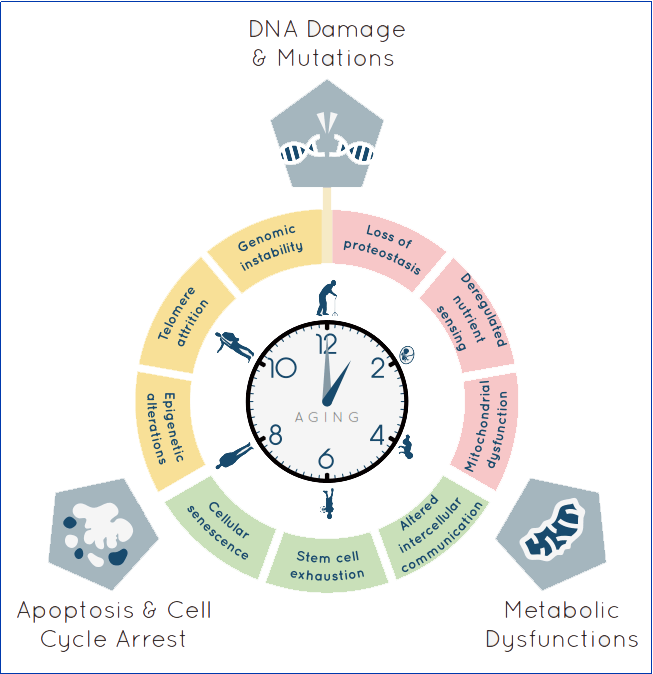
Our Advanced Cellular Repair Division goes beyond the model in the above diagram. For a start, it looks at how stem cells age because how they age determines how the body ages. There are numerous pathways that directly affect stem cell aging. These pathways control or precipitate not only aging itself but also the enemy of aging, namely, disease and inflammation. Aging, disease, and general malaise are the result of problems in these pathways. Either they have broken down or they have been silenced by certain genes turning off.
Unlike most anti-aging facilities, we are directly addressing stem cell aging pathways. Where we are able to manipulate these pathways to our advantage, the results can be potentially spectacular. Although the pathways may appear intricate, in actuality, they are not as complicated as they seem. Yet, they control, and many times seal, our fate.
We will also influence these pathways on a local basis to enhance our stem cell procedures in the joint. By affecting the chemistry in the joint with materials such as NAD, we will make a much healthier environment for the cells. A healthy environment makes for healthier stem cells. Healthier stem cells make for a healthier patient.
While other clinics focus on hormone and related treatments to try to slow down the clock of aging, our clinic is attacking aging on a cellular-molecular biology basis. The pathways of aging are related to the biological causes of aging. Let us take a closer look at the symptoms and then the pathways and examine how we are addressing them.
Epigenetics is the study of the mechanisms managing the expression of the gene pool. What genes get turned on or off can have profound consequences on our health. They can cause inflammation or help eliminate it. They can make a cell go towards a cancer line or cause the cell to self-destruct or repair itself.
Inflammation is another huge cause of aging, affecting multiple systems. The aging process is generally accompanied by a chronic, smouldering inflammation that researchers call “inflammaging”. Inflammaging leads to breakdowns in many of the different pathways.
Mitochondrial dysfunction is another huge cause of aging and is perhaps the most problematical. Aging directly concerns stem cells and their decrease in numbers as we age. Tissues don’t regenerate as well due to the slowdown of cell division and the lack of stem cell replacement.
Exhaustion of stem cells is one of the main causes of aging since it prevents cell renewal and leads to the aging of organs. Understanding the workings of stem cells will be vital for regenerative medicine and its relationship to aging in the future. In the process, we need to ask some basic “chicken or egg” questions such as, “Do problems in the aging pathways lead to decreased numbers and efficiency of stem cells or do decreased numbers of stem cells lead to problems in the aging pathways?” Such seemingly simple questions can lead to some fascinating findings and, if we pay particular attention to them, we may very well make significant progress on the anti-aging front.
If we can control aging, we can help to control and possibly prevent the diseases of aging. The following diagram illustrates the stem cell aging pathways that, in turn, represent the holy grail in our anti-aging program. Ultimately, the pathways form our playbook.
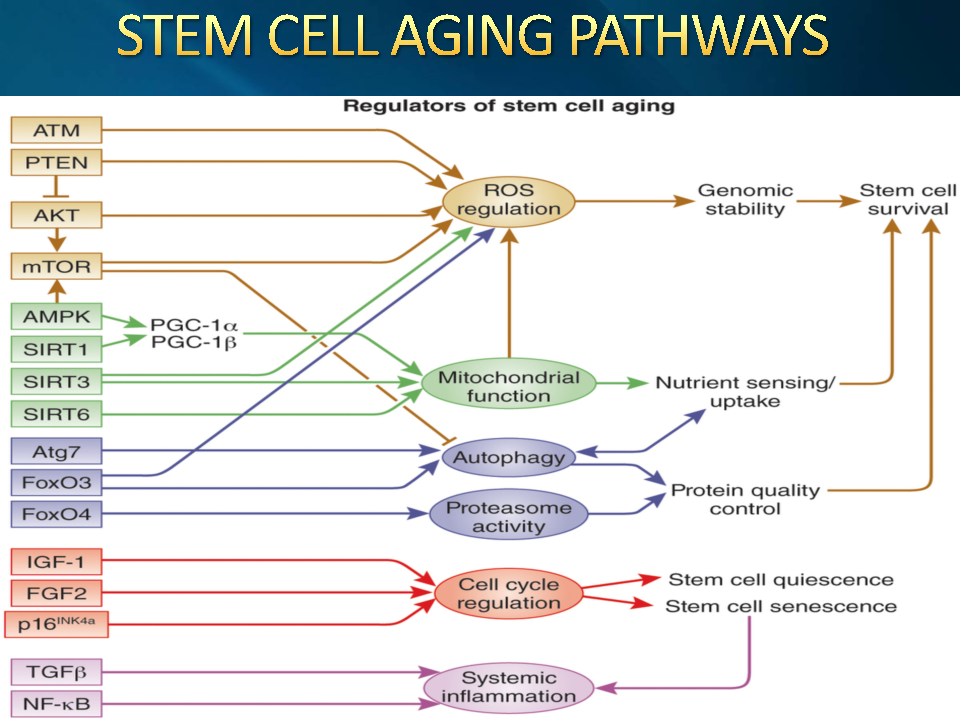
Stem Cell Aging Pathways
Sirtuin Gene Pathways [Sirt 1, 3, 6]
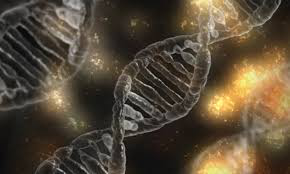
Sirtuin genes are generally regarded as one of the most important anti-aging pathways since they have a dramatic influence on mitochondria and their health. Mitochondria produce ATP which is the fuel upon which most cell functions rely. The healthier and the more numerous the mitochondria, the healthier we are. There is also a knock-on effect because these genes affect many of the other pathways. Interest from the scientific community is now considerable and serious publications are further heralding their importance. The following diagram shows where Sirtuins are found in the cell.
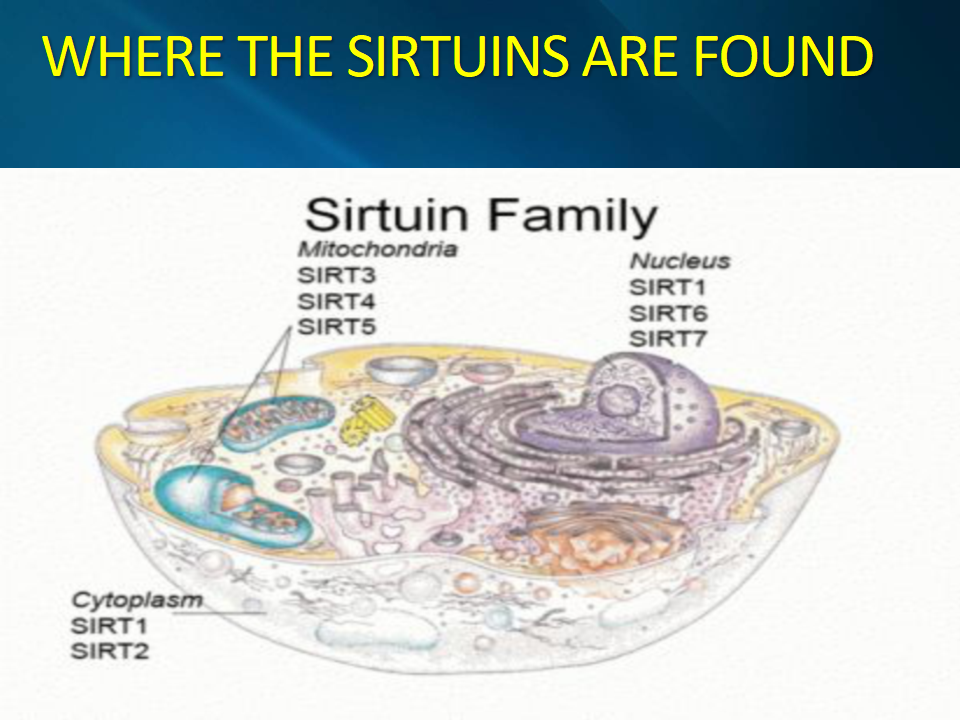
As we age, the number and function of the mitochondria diminishes. Sirtuin genes are influenced by a number of factors. One factor that turns them on is starvation or calorie restriction. Starvation is scientifically proven to slow down the clock of aging. Recently, there has been a great deal of interest in the Ketogenic Diet which seems to mimic many of the same effects of calorie restriction. Essentially it is a very low carbohydrate diet that makes the body utilize ketone bodies as an energy source. Ketone bodies have wide-ranging influence on a number of aging pathways including the Sirtuin gene pathway.
The Ketogenic diet is not just a fad but is based on firm scientific evidence that it exerts a positive influence on the clock of aging and the different aging pathways, including Sirtuin gene pathways.
Another factor that influences Sirtuin genes is Resveratrol which comes from red wine. A better alternative to Resveratrol might be Pterostilbene. Pterostilbene seem to have better bio-availability than Resveratrol. Multiple studies have demonstrated that both Resveratrol and Pterostilbene have preventative and therapeutic benefits on the mitochondria.
There are a number of other protocols that stimulate Sirtuin genes in a beneficial way. One of these is high-intensity exercise. While never knocking the value of exercise, we are now aware of a much more important compound in respect of its monumental influence on the Sirtuin gene family. That compound is called NAD.
The NAD Pathway
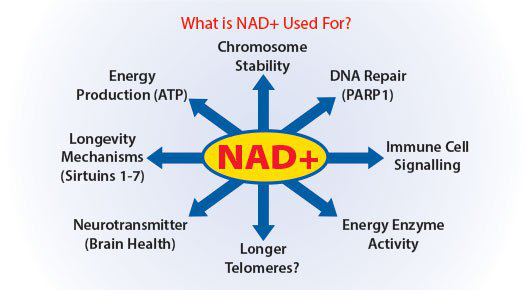
NAD stands for Nicotinamide Adenine Dinucleotide. The widely used supplement that converts to NAD is called Nicotinamide Riboside. Early in 2018, there was an article in Time Magazine touting the importance of NAD as a source and method of anti-aging. Here is an extract.
“NAD+ is the closest we’ve gotten to a fountain of youth,” says David Sinclair, co-director of the Paul F. Glenn Center for the Biology of Aging at Harvard Medical School. “It’s one of the most important molecules for life to exist, and without it, you’re dead in 30 seconds. All the good food you’re eating won’t do a thing for you if your cells can’t extract energy from it”.
NAD+ picks up electrons, becomes NADH, and drops them off as part of the cycle that turns your food into energy that you use to move and think. On a cellular level, your mitochondria, the battery packs of your cells, use that energy to do the things they need to do to stay alive and to repair themselves when there’s damage or stress.
There are a number of methods that can be used to increase the NAD available to the cells. Some of these methods include NAD supplements, a Keto-diet, intermittent fasting, and a compound called Oxaloacetate which activates the longevity pathway in a similar way that calorie restriction does. The Oxaloacetate converts to malate, which raises your NAD+ to NADH ratio, which makes more NAD+ available for your cells to use.
Sirtuins have evolved to respond to the availability of NAD+, an essential element of cellular metabolism and DNA damage repair. The sirtuins are a family of proteins that are intimately associated with NAD. It has been demonstrated that NAD+ availability decreases as we age, reducing sirtuin activities and affecting the communication between the nucleus and mitochondria.
As we age, it becomes increasingly important to supplement NAD on a daily basis. However, also as we age, although we can ingest supplements leading to NAD generation, we have difficulty delivering NAD to the cell. The same holds true even when the NAD is given intravenously. The reason for this is that, as we age, we lack a certain enzyme which dramatically facilitates the delivery of NAD to cells. In our Advanced Cellular Repair Division, we have overcome this problem.
What we have discovered is that, by itself, Nicotinamide Riboside (NR) does not promote longevity or cell health. In most organisms it is the kinase precursors (nicotinamide riboside kinase 1 &2 NRK) that signal conversion of supplemental NR to NAD. In simple terms, the kinase acts as an enzyme in the reaction to convert NR to NAD. This Kinase enzyme is thought to be the missing link. This is the enzyme that we have in diminished amounts as we age.
This kinase enzyme has now been isolated in a way that allows us to deliver it via a transdermal skin patch. The kinase enzyme will be mixed with penetrating molecules and placed on the patch. The patch is left on the skin for about twelve hours and then removed. This allows dramatically increased amounts of NAD to be delivered to the cells.
This process is revolutionary and forms part of the backbone of our anti-aging protocols. We aim to use the new kinase patches to cut down dramatically on the intravenous delivery of NAD. An initial loading dose of NAD may be given intravenously. Then, with the aid of patches, the patient will utilize oral doses to maintain adequate levels. There are no other facilities in the world that have this technology other than a few chosen clinics. For further in-depth reading, take a look at the blog on NAD and the use of kinase patches.
The following illustration shows the significance of NAD and Sirtuin genes on a variety of disease processes. Clearly, the effects of Sirtuin genes are far-ranging, leaving their footprints on various aspects of life and influencing many other aging pathways. They control how we handle free radicals through to helping to protect us from a host of bad things such as neurodegenerative diseases, diabetes, inflammatory diseases, metabolic diseases and cancer. We feel NAD is helpful in a variety of such disease conditions. It will not cure things but can mitigate many conditions and may be a good adjunct to more traditional treatment protocols.
The Far-Ranging Effects of NAD and Sirtuin Genes
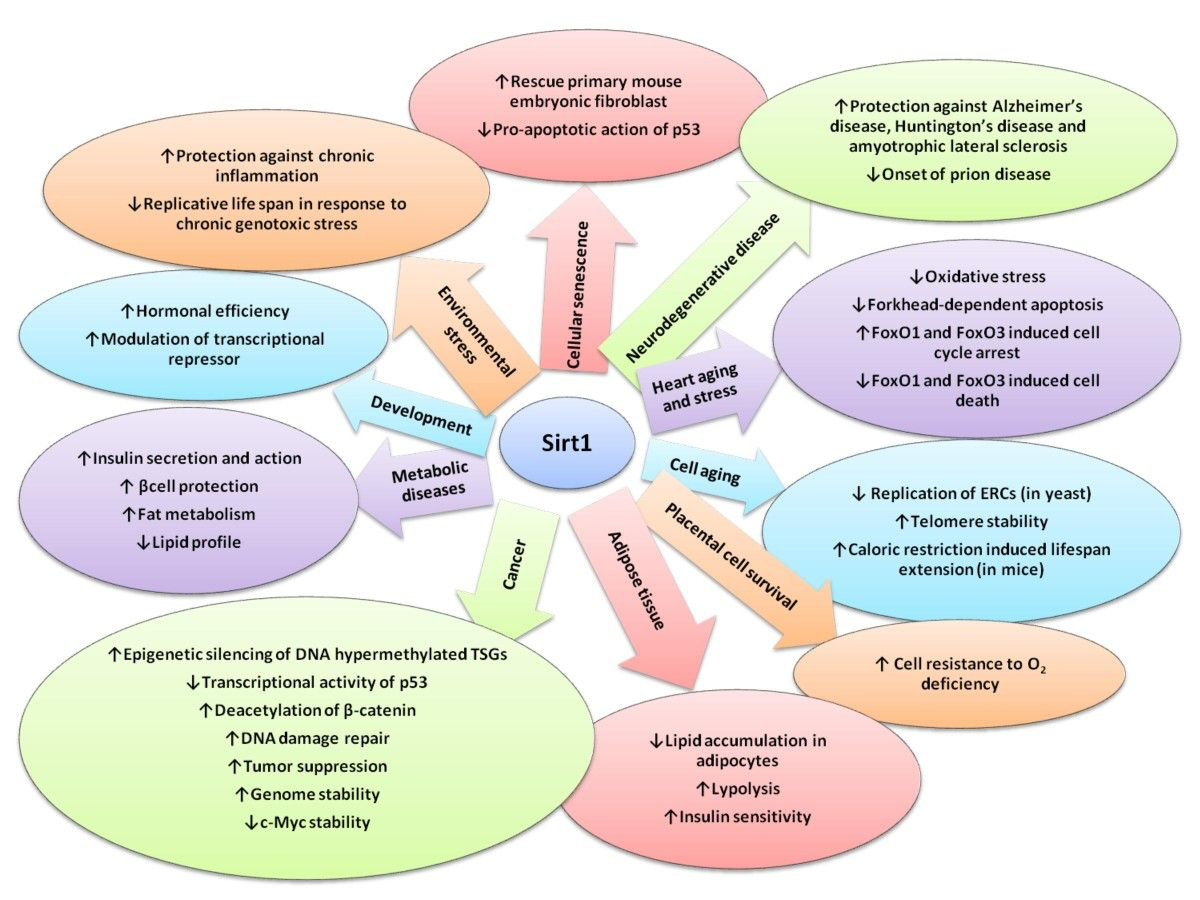
The P-53 Gene Activation Pathway
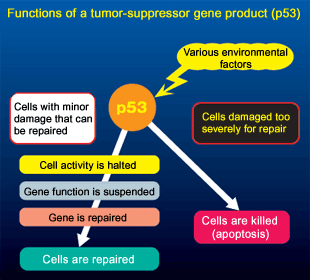
The P-53 gene is a protein known as a transcription factor. Transcription factors regulate genes by turning them on and off. A prime function of the P-53 gene is to flag down what are called senescent cells and cause them to die. A senescent cell is one which should have died but continues to survive. Cellular Senescence is a state in which cells can no longer divide but continue to live and, at the same time, secrete growth factors which can cause severe illness including cancer, diabetes, and other diseases of aging. This explains why, in some circles, it is known as the Tumour Suppressor Gene.
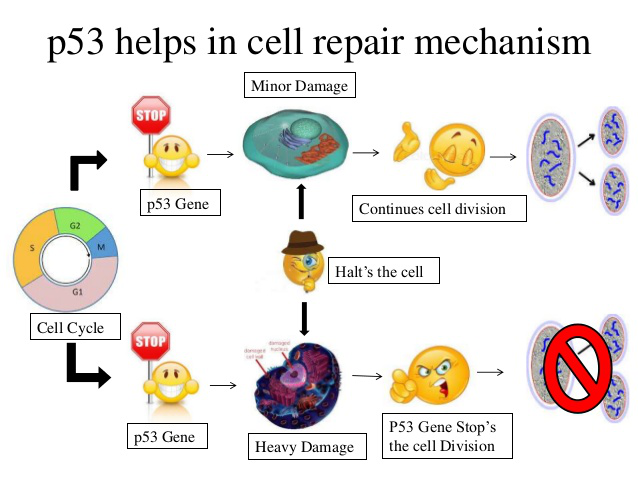
P-53 also has a great deal to do with the aging of Telomeres. Dr. Ron Di Pinho from Harvard University has proposed a unified theory of aging in which he asserts that telomere damage is a common cause for almost all the diseases of aging.
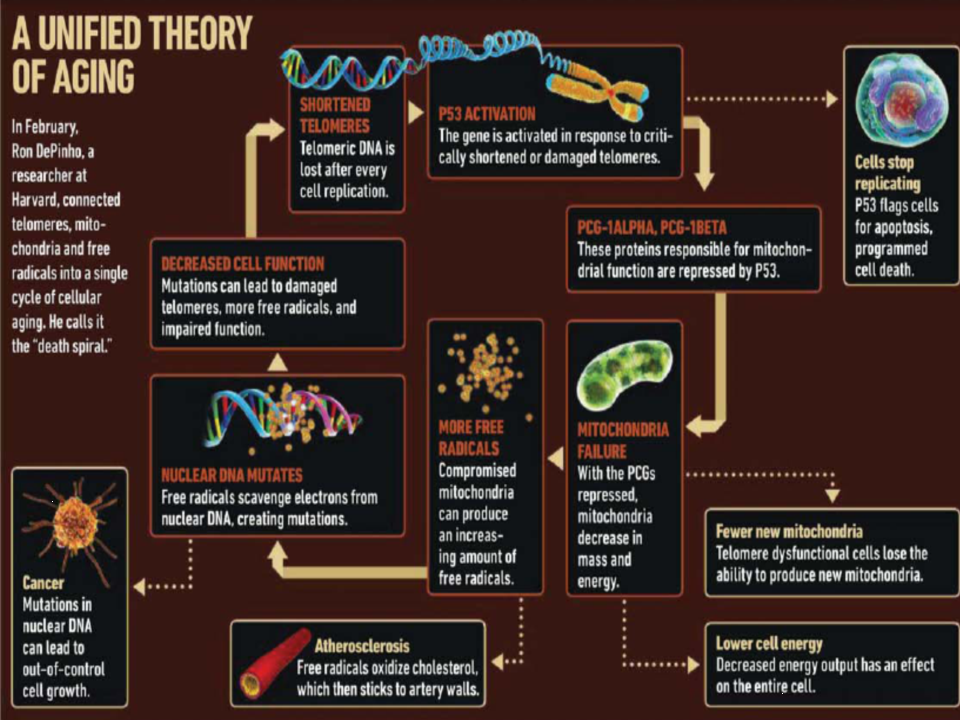
Telomeres can be simply described as tails attached to cells that represent one's DNA. We know that telomere length steadily shortens every time the cells divide, until they eventually become no longer viable and the cells die. This gives rise to two issues. One is death itself. The other is declining quality of life the shorter the telomeres become.
Short telomeres ultimately affect the mitochondria causing them to lose effectiveness and cause the "death spiral of the cell". Mitochondria produce free radicals which act much like terrorists in the body by unleashing damage on many levels. The cell is programmed such that, when its telomeres reach a certain critical level, the P-53 gene becomes active and it leads to cell death. If the P-53 gene fails, many bad things begin to happen.
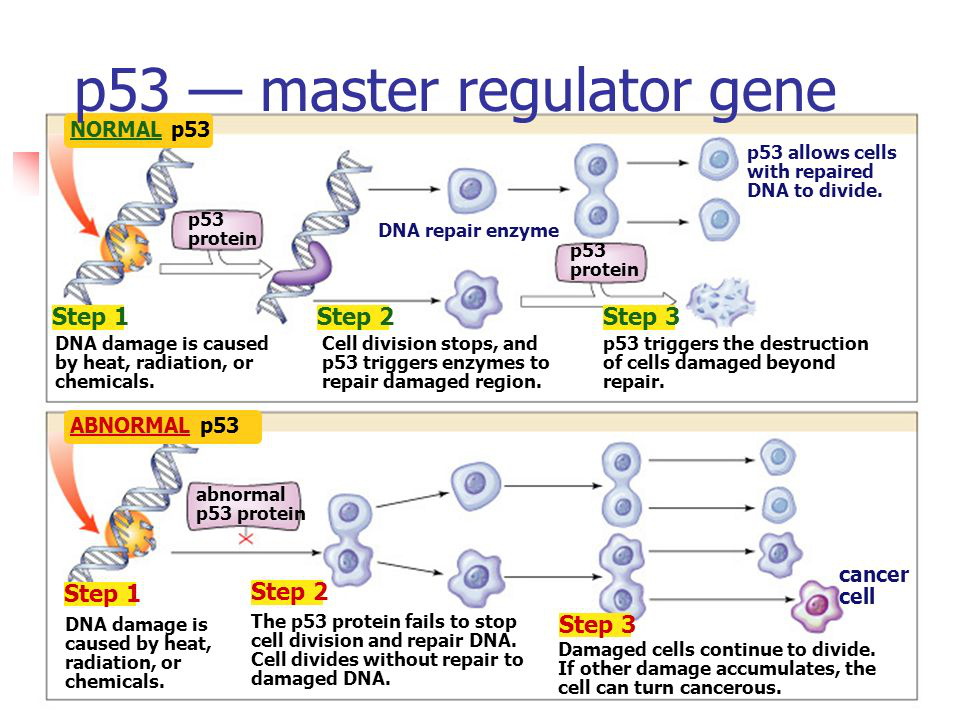
The above diagram demonstrates that P-53 can accomplish a number of different tasks, the combination of which contribute to anti-aging and anti-aging stem cell treatments in a big way.
A method of helping the P-53 gene is to use senolytic agents in the body. These are compounds that kill senescent cells, cells that should have died but instead remain alive and secrete many inflammatory growth factors. For our patients, we have a supplement that is instrumental in destroying these cells. It is an adjunct to but not a substitute for P-53.
We also have a patch that will deliver p-53 to the body. We typically recommend about three to four treatments with a P-53 patch, spaced over about a month. Each patch typically stays on the patient for eight to twelve hours. This should then be repeated at 6-monthly intervals.
The hope is that, by eliminating the senescent cells, we will eliminate the problems of aging associated with them. In addition to helping eliminate senescent cells, P-53 will also help repair cells and restore them to their younger vigour. Finally, P-53 is also called the tumour suppressor gene because it flags down senescent cells that may otherwise go on to form tumour lines.
Like many of our compounds we will deliver these medications via what we call a patchless patch. Patchless patch technology is revolutionary in that the medication is mixed with a material that can deliver the compounds down into the muscle, joint, tendon etc. where they can work their magic in a painless, efficient and targeted manner.
Here is an example of a “patchless patch” containing the P- 53 compound. The adhesive part is peeled off the frame and placed on the skin so as to appear almost invisible.
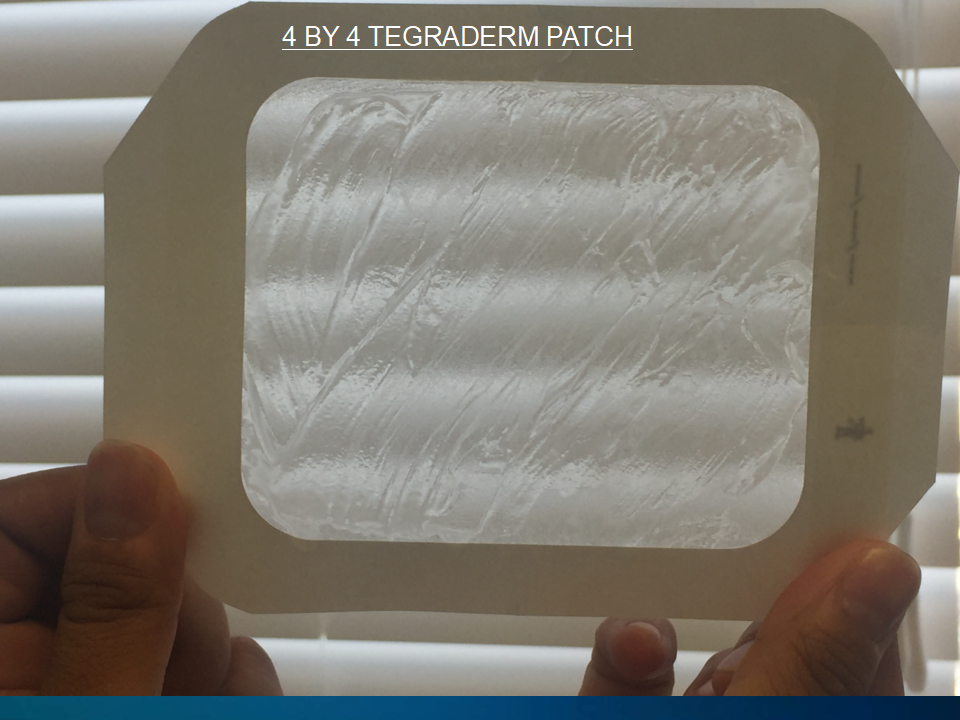
For more information on P53, go to the blogs page where there is one on the subject.
For more information on Telomere length, go to the V-cell page under Treatments and Science.
The mTOR Pathway

The mTOR pathway is also of great importance in the field of anti-aging. “mTOR” stands for mechanistic target of rapamycin, derived from its inhibitor rapamycin, which was initially isolated in the 1970s from a soil bacterium on Rapa Nui (Easter Island).
Rapamycin, also known as sirolimus, forms a complex which inhibits the activity of mTOR. Rapamycin was first described as an antifungal drug and used to inhibit the growth of yeasts. Later, it was found to have great potency in decreasing the proliferation of T lymphocytes. T lymphocytes are a type of white blood cell that is of key importance to our immune system. These cells are at the core of adaptive immunity which is the system that tailors the body's immune response to specific pathogens. T cells are like soldiers who search out and destroy the targeted invaders.
We now know that the role of mTOR goes far beyond proliferation and coordinates a cell-tailored metabolic program to control cell growth and many biological processes including molecular mechanisms aging and age-related processes such as cellular senescence, metabolism, and stem cell function.
Inhibition of the mTOR complex 1 (mTORC1) with rapamycin is currently the only known pharmacological treatment that increases lifespan in all model organisms studied and the only one in mammals. Recent studies allow us better to understand the clinical consequences of mTOR inhibition in rapamycin-treated individuals.
The mechanistic target of the rapamycin (mTOR) network is an evolutionary conserved signalling hub that senses and integrates environmental, intracellular nutrient and growth factor signals. These signals coordinate basic cellular and organismal responses such as cell growth, proliferation, apoptosis, and inflammation depending on the individual cell and tissue.
Since the water-solubility of Rapamycin is poor, which effects its bioavailability, several analogues of Rapamycin (compounds that act similarly) have been developed, generally termed rapalogs. Rapalogs include rapamycin (known clinically as Sirolimus or Rapamune), everolimus, temsirolimus (a rapamycin prodrug) and deforolimus (Ridaforolimus). Rapalogs are prescription drugs taken by organ transplant recipients and cancer patients. There are some potential side effects to be aware of when using rapamycin. Alternatively, we can look to natural products.
Recent studies have demonstrated that a number of natural products (or nutraceuticals) isolated from plants (e.g. fruits, vegetables, spices, nuts, legumes, herbs, etc.) also inhibit the mTOR pathway, and exhibit potent anti-cancer properties. These particular natural products are considered “natural rapalogs”. Some of these products include N -acetyl cysteine (NAC), indoles (cruciferous vegetables), Reishi mushrooms, a number of polyphenols (including Apigenin, Curcumin, EGCG found in green tea, Fisetin, Quercetin and isoflavones), R-Lipoic acid, and certain forms of Vitamin E. For our patients, we have formulated a range of supplements that contain a number of these compounds.
One other aspect of the mTOR pathway is that it seems to be more efficient than Metformin for anti-aging. Metformin is a common diabetes medicine, also known to be important for anti-aging and anti-cancer. The benefit of Metformin seems to arise from its effect on certain bacteria of our gut.
Metformin extends the lifespan of worms and most rodents. It decreases all-cause mortality in humans. It also prevents several age-related diseases in humans. Yet, Metformin did not increase lifespan in some model organisms such as mice. The spectrum of Metformin-responsive diseases is narrower than those for rapamycin. As a monotherapy, the life-extending effect of Metformin may be modest, but it can be combined with rapamycin or rapamycin like drugs to increase anti-aging activities.
Metformin is a good transition point to our next pathway, the AMPK pathway.
The AMPK Pathway
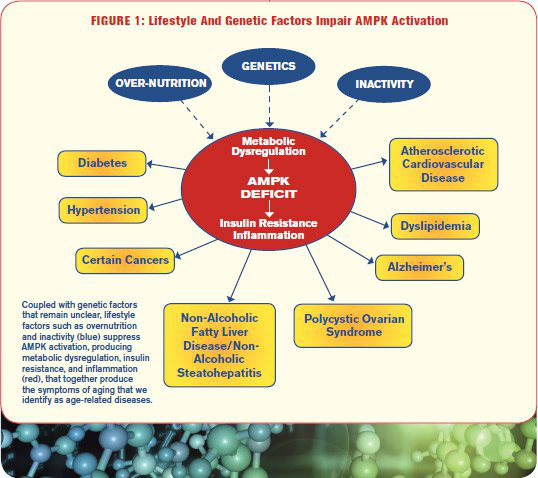
The AMPK pathway is found inside every cell and serves as your body’s “master regulating switch.” The most compelling evidence that activating AMPK can help you live longer comes from a study released in 2014. In that study, diabetic patients who were treated with the drug Metformin, a potent AMPK activator, lived a median of 15% longer than did matched controls without diabetes.
AMPK stands for adenosine monophosphate-activated protein kinase. It is an enzyme that plays a critical role in cellular homeostasis. AMPK activity is one of the keys for mitochondrial biogenesis and declines with age. AMPK acts as a master switch to regulate cell functions such as uptake of glucose, burning of fats, and formation of new mitochondria. It determines body fat composition and how long you’ll live. So, here again, we have contributory anti-aging stem cell treatment.
When switched “on”, AMPK triggers the use of stored energy from fats, enhances removal of fats and sugar from the blood, increases production of mitochondria, and reduces inflammation and cellular debris. Calorie restriction and vigorous exercise activate AMPK, shrinking body fat stores (especially in the belly region), lowering blood sugar and lipid levels, and producing other beneficial effects that retard the aging process. An important property of AMPK is that it induces multiple longevity factors, which have been shown to increase stress-resistance and extend lifespan in many organisms.
Nutritional overload impairs AMPK activity. It thus should not be surprising that one method of maintaining higher AMPK activity is calorie restriction. To better understand how this works, in a low-calorie environment, cells turn “on” survival signals (such as AMPK) to optimize their energy balance.
Chronic overeating deactivates AMPK and shortens lifespans. The good news is that we can restore our dwindling AMPK activity through a combination of lifestyle, diet, and supplement interventions, with the possibility of significantly increasing lifespan through mitigation of potentially fatal symptoms of aging. AMPK is stimulated by muscle contraction. Most notably and well researched, high intensity interval training (HIIT) is powerfully effective in activating AMPK.
We address the AMPK pathway on a number of different levels. We have developed a variety of methods which will increase the amount of AMPK found in the body. We know that a number of supplements seem to stimulate this pathway. Some of these supplements include NAD, Pterostilbene, Acetyl-L-carnitine (ALCAR), and Berberine.
The Autophagy Pathway
Autophagy is a process that acts as our body’s innate recycling system. The majority of autophagy is controlled by mammalian target of rapamycin (mTOR). When nutrients are limited, mTOR is activated, which in turn induces autophagy. One characteristic of aging is the accumulation of damage, and this is largely due to the failure of autophagy to attain normal functional levels. Bringing levels of autophagy to youthful levels can ameliorate aging by clearing out damaged parts of the cell. Cells use autophagy to get rid of damaged proteins and organelles, to counteract the negative effects of ageing on the body. In short, autophagy is central to extending lifespan and to avoiding the diseases of aging.
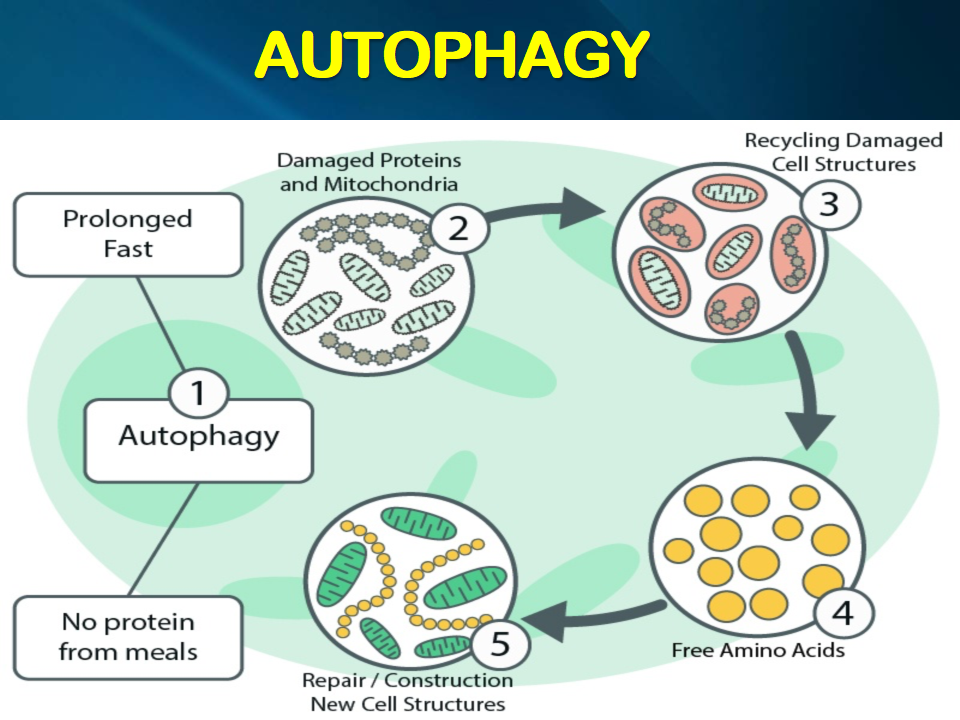
Most anti-aging treatments and protocols have something in common: they all cause an increase in autophagy. Let us look at some of the methods of increasing autophagy.
A keto diet (a high-fat, low-carb meal plan) is a good method of achieving Autophagy. The shift from burning glucose (carbs) to ketones (fats) that occurs on a keto diet mimics what occurs naturally in a fasted state and this increases autophagy. Intermittent fasting or restricting caloric intake for a short period of time, has been shown to induce autophagy. When your cells lack nutrients, it stresses them. This is a good thing because it increases the rate at which cells recycle components. A lack of nutrient influx activates autophagy to increase the recycling of cellular components, ensuring cells continue to function properly with less assistance from external resources.
High-intensity interval training is another way to stimulate autophagy. Remember, autophagy is a bodily response to stress, and high-intensity exercise puts you in the good-stress sweet spot because it stresses you just enough to provoke biochemical change. You’ll get just enough impact load to make your muscles stronger (and induce autophagy) without harm. One should aim for approximately 20-30 minutes a day of high intensity exercises to give your longevity an optimal boost.
There is a range of supplements that also contribute to autophagy. Again, these will be made available to our patients.
Conclusions on Stem Cell Aging Pathways
- All stem cell aging pathways attempt to eliminate senescent cells whilst, at the same time, increasing the number and efficiency of mitochondria.
- The pathways seem to overlap with each other and affect the mitochondria in a variety of ways, all of which need to be considered in formulating solutions.
- P-53 and NAD are expected to be lynch-pins in our treatments, clearing the way for other pathways to do their jobs.
- ATP production is the essence of life. Increase its production and generally we are healthier.
- If we are able to direct the pathways of aging, then we should be able to slow down the aging process. In turn, optimising these multiple pathways will allow more conventional methods of age management, such as bio-identical hormones, to function more successfully.
- Anti-aging is a very fluid and fast-moving science. For our part, we shall strive to remain on the cutting edge of the cutting edge by identifying and addressing the root causes of aging.
Hybrid Treatments
Our anti-aging treatments currently include both intravenous and patch therapy. However, over time we expect that patch therapy will eventually predominate.
The centrepiece of our hybrid therapy will be the delivery of NAD via IV and patchless patch. Some of the other hybrid treatments are set out as follows.
CoQ-10
CoQ-10 (Coenzyme Q10) is an antioxidant that your body produces naturally. Your cells use CoQ-10 for growth and maintenance. Coenzyme Q10 is a compound that helps generate energy in your cells. Health conditions like heart disease, brain disorders, diabetes, and cancer have been linked to low levels of CoQ-10. It is not clear whether low levels of CoQ-10 cause these diseases or result from them. One thing is certain though: plenty of research has revealed CoQ-10 ’s wide range of health benefits. CoQ-10 is present in every cell of your body. The highest concentrations are found in organs with the greatest energy demands, such as the heart, kidneys, lungs and liver.
According to leading experts on the cutting edge of natural health, it is critical to supplement with CoQ-10 as you age. After the age of 30, your natural levels of CoQ-10 begin to diminish. By the age of 50, this depletion of CoQ-10 begins to accelerate. By the age of 70, your natural CoQ-10 levels may be 50% of what they were as a young adult. Unfortunately, as we age, it is difficult to get adequate amounts of CoQ-10 through diet or supplements.
We are one of very few clinics currently able to deliver CoQ-10 to the cells both by IV and by patch. For the patch, CoQ-10 is combined with penetrating molecules that deliver large amounts of CoQ-10 to the targeted cells where it is needed. We have used these patches for years in our V-cell procedures. Usually we recommend an initial IV dosage of CoQ-10 followed by the patches.
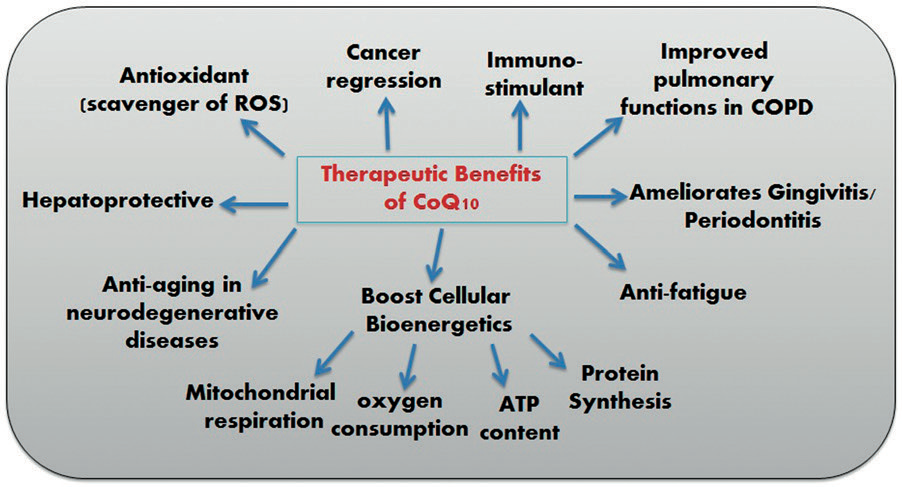
CoQ-10 is involved in making adenosine triphosphate (ATP), which is involved in energy transfer within cells. Its other crucial role is to serve as an antioxidant and protect cells from oxidative damage. Excessive amounts of free radicals lead to oxidative damage, which can interfere with regular cell functioning. This is known to cause many negative health conditions.
Another function of CoQ-10 is its effect on stem cell output from bone marrow. For example, we know that it will increase the output of V-cells from bone marrow. A V-cell is a special stem cell found in everyone. It is considered a very strong stem cell in both its capacity to give rise to many different types of cell and to arrest the decline in telomere length, a core contributor to the diseases of aging. We make use of CoQ-10 to increase V-cell output when doing V-cell treatments, aimed to help rejuvenate our immune system. The younger our immune system the healthier we are and activated V-cells are constantly on patrol for bad things. In sum, CoQ-10 is a powerful contributor to stem cell anti-aging treatments.
One final and important note is that statins seem to rob the body of CoQ-10. Anyone taking a statin needs to be vigilant about taking extra doses of Co-Q-10.
Glutathione
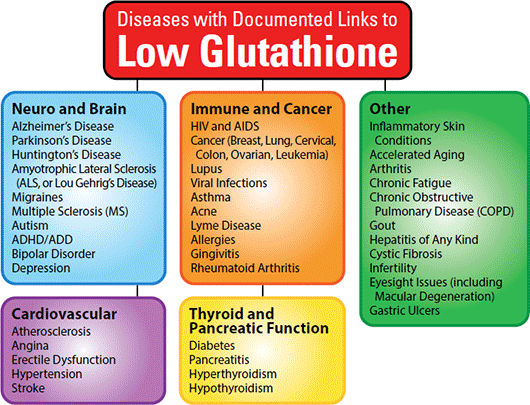
Your cells contain glutathione, a substance made from three amino acids: cysteine, glutamate, and glycine. Glutathione acts as an important antioxidant in your body. That means it helps combat free radicals. A free radical is called a Reactive Oxygen Species also known as ROS. These are molecules that can damage your body's cells on many different levels. Many of the aging pathways involve ROS.
Glutathione also plays a role in many chemical reactions in your body. It helps detoxify chemicals, including some that your body creates naturally, as well as pollutants and drugs.
Your supply of glutathione seems to decrease as you get older and lower glutathione levels appear to go hand-in-hand with poorer health. For instance, lower levels may play a role in many conditions that are more likely to develop in older people.
Again, with our hybrid methods of delivery, we feel that this will allow more glutathione to enter the cells and work its magic.
Quercetin and Curcumin
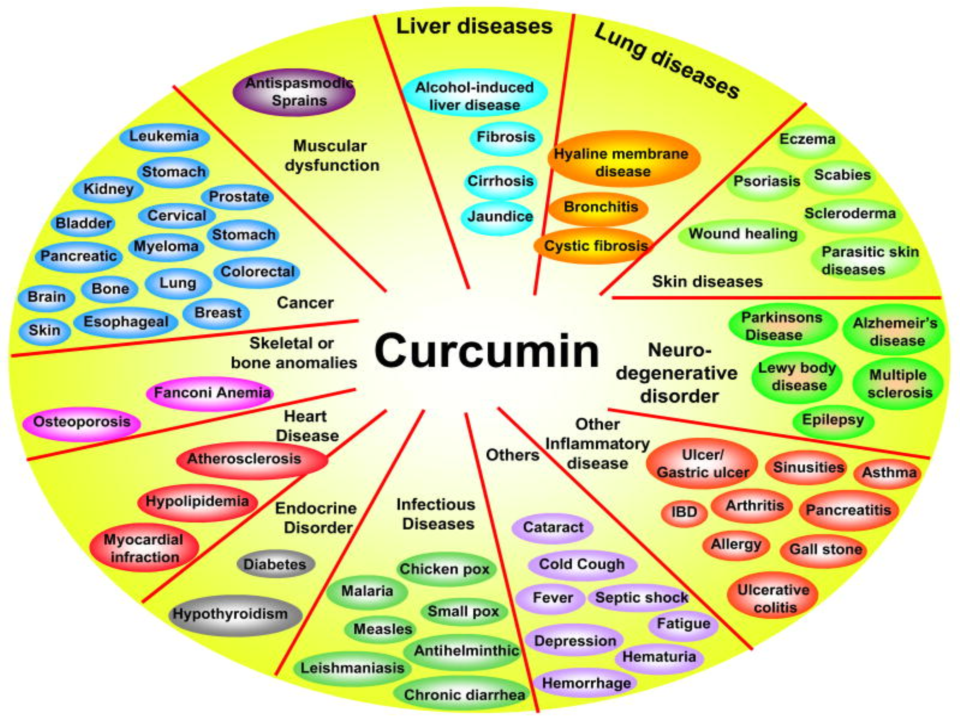
The above diagram gives some ideas of the power of curcumin. It appears to have far-reaching effects in many aspects of medicine. We utilize a very potent bio-available form of Curcumin and with Quercetin we have developed a patch delivery system which will again eliminate the bioavailability issue.
Meyers Cocktail

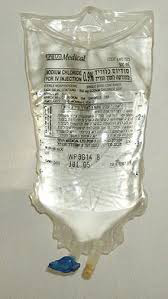
Myers Cocktail intravenous therapy is a mix of vitamins and minerals developed by John Myers. It is commonly used to enhance the immune system, treat chronic fatigue, assist with allergies, and reduce symptoms of Fibromyalgia. The cocktail, which is administered intravenously, easily bypasses the liver, providing key nutrients for energy production. The Myers’ Cocktail works by increasing the blood concentration of several essential vitamins and minerals beyond that which can be achieved via oral supplements. For example, Vitamin C given intravenously has been found to reach blood concentrations more than 50 times greater than what can be achieved when given orally and this is useful for certain conditions. We are currently evaluating a patch therapy for vitamin C.
Cytokines - Cyto-Amino-Complexes
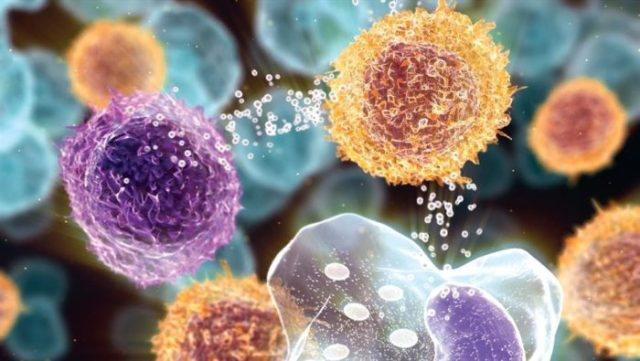
Cytokine therapy is one the new exciting fields in medicine which, like stem cells, has the ability to change the face of medicine dramatically. Cytokines—from the Greek cyto- (“cell”) and kinos (“movement”)—are tiny cell-signalling protein molecules secreted by various cells. They may be classified as peptides, proteins, or glycoproteins. Together, cytokines form a communication system for the body. Cytokine Medicine truly represents a quantum leap in medicine, particularly in the field of regenerative medicine.
For years, we have been using cytokine therapy to enhance results with our stem cell and PRP treatments. Growth factors are cytokine signalling molecules that are typically secreted at the site of repair by many different cell types including platelets, stem cells and fibroblasts. These growth factors bind to the cell membrane and start the cascade of DNA synthesis, mitosis and cell repair. Some of these growth factors affect the stem cell environment or as it is sometimes called the “stem cell niche”. It will make the environment much more favourable for the functioning of various stem cells and, in turn, contribute to our armoury of anti-aging stem cell treatments.
INTRAVENOUS VITAMIN C
IVC THERAPY IS A LIFE CHANGER
IV therapy is a wonderful way to get a high dose of vitamins, minerals and antioxidants directly into the bloodstream. With this method, the nutrients are rapidly infused into the circulation and are delivered directly into the cellular space without having to go through the digestive tract.
VITAMIN C is a foundational nutrient, meaning it supports a healthy foundation and overall well-being for everyone. Many people notice superior immunity, increased energy and enhanced detoxification from the improvement in cellular health. When cellular health is supported, the body is able effectively to utilize the nutrients supporting the major bodily systems.
Vitamin C is most well known for its role as an immune system regulator, with many people using it to prevent or treat colds and flu. However, this is only a small part of what this versatile nutrient can do. As an antioxidant, vitamin C prevents the oxidation of LDL cholesterol, a catalyst in heart disease progression. Studies show that higher intakes of vitamin C are associated with a reduced risk of a number of cardiovascular diseases.
Vitamin C is also a cofactor for a number of reactions that occur in the body. It is required for collagen formation, necessary for wound healing and maintaining the structure of skin and gums. It is involved in the synthesis of important hormones and neurotransmitters and supports the function of the adrenal glands. It helps to protect cells and DNA from oxidative damage and is critical for anti-aging and reducing the risk of many degenerative diseases. Indeed, this is one of vitamin C’s most important roles.
Furthermore, vitamin C increases the absorption of non-heme iron. Heme iron comes from animal proteins in our diet such as meat, seafood and fish. Non-heme iron is found in plant-based foods like grains, beans, vegetables, fruits, nuts and seeds. Thus, for those who eat little meat or fish, adequate intake of vitamin C becomes increasingly important.
HUMANS CANNOT PRODUCE VITAMIN C
We must consume it from our foods or supplement sources. The main problem with taking an oral vitamin C supplement is that only a small percentage of the vitamin C consumed can be absorbed by our bodies. By contrast, IVC places vitamin C directly into your blood stream where it can reach much higher concentrations. This route increases the benefits with very few, if any, side effects.
The vitamin C we use is processed from raw tapioca and is neither corn nor glucose sourced. Tapioca C is a high-dose vitamin C product and is an ideal alternative for individuals who prefer vitamin C from a whole food source that is also hypoallergenic [unlikely to cause allergic reactions].
BENEFITS OF INTRAVENOUS VITAMIN C
- It is one of the best anti-virial agents available. It enhances our host resistance and improves our immune system's ability to neutralize bacterial, viral, and fungal infections.
- It can eliminate a wide range of toxins and even has a mild chelating effect for the removal of toxic heavy metals such as cobalt & chromium.
- It has an antihistamine effect which is useful in fighting allergies. When we lack vitamin C, we are prone to an increase in asthma attacks and allergy symptoms.
- It has anti-inflammatory, anti-stress and anti-depressant properties.
- It can correct the symptoms of a possible vitamin C deficiency such as fatigue and bleeding.
- It can enhance wound healing after surgeries and biopsies.
- It is essential for the synthesis of collagen, the main structural protein found in connective tissue. This collagen stimulation can also help the body to wall off malignant tumors.
- In high doses, IVC has a pro-oxidant effect resulting in the formation of hydrogen peroxide. It can then selectively target malignant cells WHILE leaving normal cells unharmed!
- It supports the formation of bone marrow and especially the platelets.
SUPPORT FOR THE ENTIRE BODY WHILE HAVING THE ABILITY TO HELP FIGHT CANCER
IVC is used to help in the treatment of a host of acute and chronic conditions including cancer. Clinical research has demonstrated that high doses of vitamin C are exclusively toxic to cancer cells, while leaving healthy tissue unharmed.
Thousands of lives have been changed because of IVC treatments!
- IVC is complementary to oncologic care. It is not an either/or proposition.
- When patients receive IVC, they report that they are better able to tolerate chemotherapy. They also report fewer side effects, faster healing, more resistance to infections, better appetite, less pain, and that they remain more active.
- Patients bounce back quicker because IVC reduces the toxicity of chemotherapy and radiation WITHOUT compromising their cancer cell killing effects.
- IVC therapy should not be performed on the same day as chemotherapy or radiation treatment. Post treatment, drink plenty of fluids (unless restricted by your doctor). It may be helpful to eat a small meal or protein rich snack following IVC therapy to avoid fluctuations in blood sugar.
POTENTIAL SIDE EFFECTS
- Some patients complain of shakiness during or soon after receiving IVC. This is often due to blood sugar (glucose) fluctuations and is relieved by eating prior to the infusion. Shakiness can also be caused by low calcium or magnesium levels.
- Vitamin C infusions can cause inaccurately high results on finger stick blood glucose readings. Glucometer readings cannot be relied upon for at least 6 hours after completion of an IVC infusion. However, standard serum glucose testing is unaffected.
- Given the amount of fluids a patient receives during IVC, any condition that could be adversely affected by fluid or sodium overload is a contraindication to receiving IVC. Conditions in question, or needing close monitoring, include congestive heart failure (CHF), acute or chronic renal failure/insufficiency, edema, ascites secondary to liver disease, etc.
- With any IV infusion, bruising, infiltration, and some pain at the needle site is can occur.
REGENERATIVE MEDICINE THE BENEFITS OF NAD
- The principal benefits of NAD are found in the following areas:
ANTI-AGING BENEFITS
NAD plays a major role in the aging process, in part by regulating the circadian and metabolic cycles and acting as a regulator for new proteins. NAD plays a role in the regulation of the Sir2p family, which influence lifespan and aging. Changes in metabolism can lead to the development of certain age-related pathologies.
This coenzyme also helps protect the integrity of DNA, which becomes damaged over time from wear and tear, duplication errors, and the damaging effects of free radicals. NAD is especially important in regulating inflammation that damages DNA over time. In addition, NAD can correct existing damage.
NAD is believed to play a role in arresting the shortening of telomere length and possibly contributing towards increasing telomere length. This is very important. Telomeres are protective caps located at the ends of chromosomes that naturally get shorter every time a cell divides. At a certain critical telomere length, the cells die. As they approach that critical length, short telomeres have been associated with virtually all the diseases of aging.
The body naturally produces NAD, but as the body ages, overall levels decrease and leads to the development of age-related conditions. Restoring and supplementing NAD in the body can improve physical appearance, health, and quality of life.
Benefits include:
- Improved prevention and correction of damage to DNA
- Restored muscle function and athletic performance
- Boosted energy levels
- Improved appearance
- Reduced fatigue
NEUROLOGICAL BENEFITS
NAD increases your body’s levels of serotonin, a neurotransmitter associated with mood regulation, and can improve symptoms of depression and anxiety. A decrease in cognitive ability is a hallmark of aging. There are many age-related neurological conditions including dementia, decreased focus, and memory problems.
NAD rejuvenates and restores brain function inter alia by boosting sirtuins – proteins that slow the effects of neurodegenerative diseases and natural cognitive decline. Together, NAD and sirtuins protect against toxicities in the body and improves cells’ resistance to stress.
Benefits include:
- Improved brain health and neurological function
- Improved symptoms of depression and anxiety
- Improved mental clarity [clearing “brain fog”]
- Improved focus and concentration
- Improved brain regeneration
- Improved mood stability
- Improved memory
ADDICTION AND RECOVERY BENEFITS
NAD has proved helpful for individuals undergoing therapy for substance abuse and addiction recovery. The treatment reduces cravings and withdrawal symptoms, provides energy to the body, and boosts brain regeneration. It is a holistic alternative to medication-based solutions and is especially useful for patients who want to avoid the side effects of medications.
NAD detoxifies the body, helping the replacement of essential vitamins and nutrients that are typically depleted in individuals who engage in substance abuse. NAD reduces withdrawal symptoms by binding to opiate receptors, which can help individuals overcome cravings and risk of relapse. At the same time, this powerful coenzyme naturally protects the brain which, in turn, accelerates recovery.
Benefits include:
- Reduced cravings associated with withdrawal
- Fewer withdrawal symptoms
- Improved cognitive clarity
- Improved brain function
- Restored energy levels
- Improved mood
- Cell restoration
NAD therapy for addiction and recovery is not a cure in its own right. It should be used in tandem with counselling or therapy.
METABOLIC BENEFITS
The term ‘metabolism’ refers to the amount of energy that is expended to maintain the body. The metabolism naturally slows with age and can lead to weight gain and lower energy levels. NAD plays a large role in normalising metabolic function which, in turn, helps to improve weight loss and overall energy level.
NAD helps promote mitochondrial fitness by maintaining the mitochondrial unfolded protein response, a reaction to cell stress, by ensuring that these cells form into the correct shape for normal function. NAD helps the liver break down fats that are essential to provide energy for the body. It also helps create ATP, which is a major source of energy for cells.
Benefits include:
- Increased energy levels
- Improved metabolism
- Increased weight loss
- Decreased fatigue
NAD+ SUPPLEMENTATION
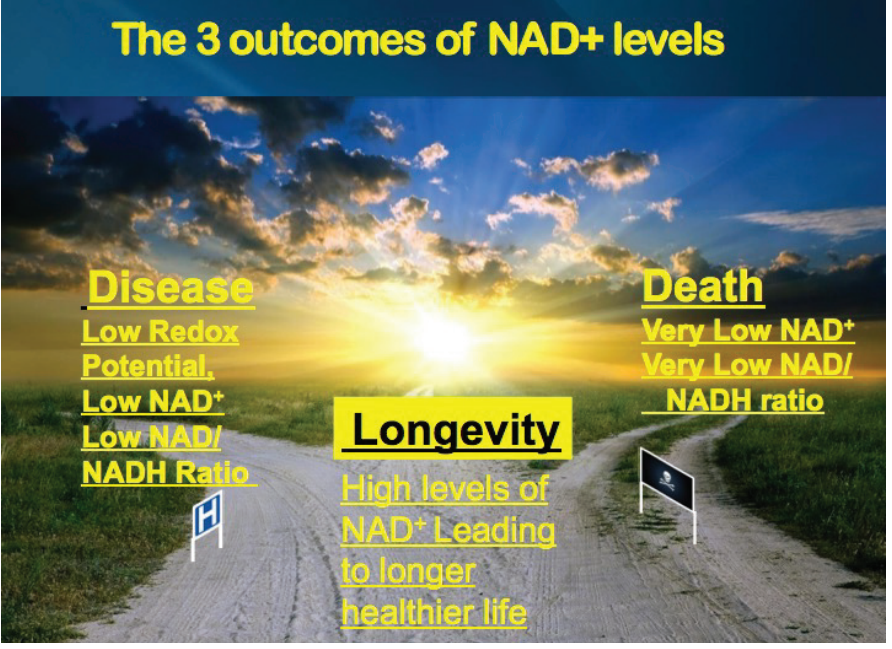
WHAT IS YOUR PATH?
The above diagram sums up the choice of paths you can take when it comes to NAD levels. Very low NAD can lead to death. Low NAD can lead to disease and then possibly to death. High NAD helps lead to a longer and healthier life.
WHAT IS NAD?
Nicotinamide adenine dinucleotide (NAD) is a coenzyme discovered over 100 years ago by scientists studying fermentation. NAD does two essential things in the cell. First, it aids in the process of turning nutrients into energy - a crucial part of cellular metabolism and the beginning of every energy-driven process in our bodies. Second, NAD is known to boost the activity of sirtuins, an essential protein used by the cell. Sirtuins promote mitochondrial health and support overall cellular health when they are active and working hard.
NAD+ is the oxidized form of NAD and is found in all living cells required for fundamental biological functions at a cellular level. You literally can’t live without it. But NAD+ levels decline with age, and low levels of NAD+ are often associated with poor health. The chart below demonstrates this decline.
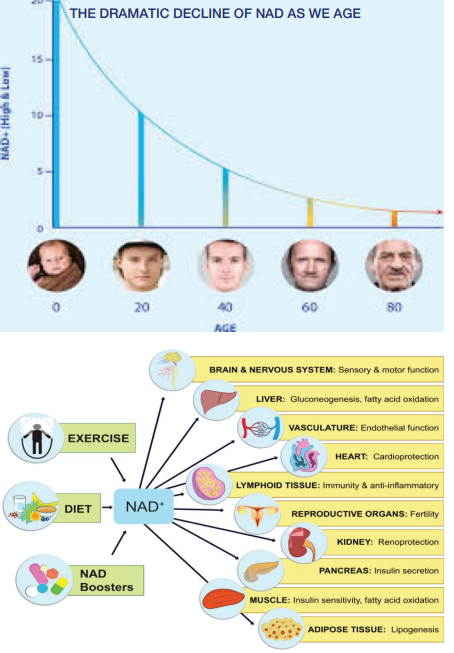
As a result of this decline, the scientific community has been researching how NAD+ relates to overall health and age-related diseases. NAD+ has earned its reputation by playing a role in the body’s central biological functions. NAD+ is essential in the production of energy especially the Krebs cycle, which produces energy, namely ATP. NAD+ also works throughout the body to support mitochondrial function, oxidative stress defences, cellular respiration, and DNA repair. We should think of the mitochondria as the body’s batteries. The following diagram shows the some of the aspects of health NAD+ touches.
Your body already makes and maintains NAD+ in various ways, specifically by converting food in your diet to NAD+. But since NAD+ levels decline with the aging process, it’s important to understand that you must increase your levels in other ways.
It’s not entirely known why NAD+ declines with age, but what’s suspected is that NAD-consuming enzymes, which provide various benefits to the body’s biological function and overall health, essentially “use up” NAD+. Many of these NAD-consuming enzymes are concerned with repairing various types of damage that come from aging. The older we get the more damage that needs to be fixed and thus the more NAD+ we need but the less we have. At the same time, important repairs need to be done.
PARPS
One such repair mechanism involves a group of enzymes called PARPs, or poly (ADP-ribose) polymerases. These enzymes rely on NAD+ to function and regulate DNA repair, among other biological functions. Without PARPs the body would be in BIG TROUBLE since DNA could not be repaired. The problem with the PARPs is that they are tremendous users of NAD. Perhaps a good analogy with the PARP enzymes is to think of them as the Pac Men from the old video game. Think of these Pac Men enzymes as large consumers of the NAD and NAD as the dots that Pac Men consume.
SIRTUINS
NAD+ is also an essential cofactor of key enzymes responsible for longevity called sirtuins. While resveratrol is well known for sirtuin activation, evidence indicates it does so indirectly, whereas NAD+ directly activates sirtuins to regulate the genes of aging. Sirtuins, specifically Sirt1and Sirt3, are intimately related to longevity through their control of gene expression and require NAD+ for their activity. Research into sirtuins continues to yield substantial information on how to control aging. By activating these sirtuins, we’re able to gain control over one of our body’s anti-aging “switches.”
SIRT enzymes “turn off” certain genes that promote aging, such as those involved in inflammation, in fat synthesis and storage, and in blood sugar management. SIRT enzymes are activated by calorie restriction, the proven means of reliably extending life span in all organisms. The way calorie restriction activates anti-aging sirtuins is by increasing cellular NAD+. Perhaps one of the most important aspects of the Sirtuin genes is that they control mitochondria biogenesis (production) and maintain the health of the existing mitochondria.
DELIVERY
NAD+ can be delivered to the cells by a number of different methods. We must realize that there are a number of NAD+ precursors. There are some oral precursors such as Niacin which is one of the Vitamin B3 class. Niacin is not very efficient in producing NAD+. It can also have some significant side effects such as flushing. A better B3 vitamin choice is nicotinamide riboside (NR). NR boasts the double whammy of not causing flushing and getting along great with sirtuin genes. This gives it an edge over the other vitamin B3s because it increases NAD and can kickstart sirtuins that support overall cellular health. However, the best source of NAD+ precursor is NAD+ via an intravenous route. This is the best method of boosting NAD+ levels in the body.
NAD KINASE
But this is still not the complete story. There is one missing ingredient, an enzyme called NAD Kinase which will dramatically increase the amount of NAD+ that enters the cells. However, as we age, there is a significant drop in the production of NAD Kinase and there is really no effective method of increasing it through supplements.
However, we are able to increase the amount of NAD Kinase via a patch placed over the skin. This is a revolutionary proprietary approach, so the product is simply not available in most other facilities. Between IV treatments of NAD+, we can supply NAD Kinase patches to maintain high levels of NAD+.
We also have treatments that can prolong the life of NAD+ by eliminating the negative effects of certain enzymes.
Mega-Burn Injections
These injections are an excellent option for individuals looking to lose some extra pounds, have more energy and improve their overall quality of life. It helps boost your energy by attacking those stubborn fatty acids and metabolizing that fat into energy
It is packed with essential vitamins your body needs to function normally and at its best. As many people mature, their body often has a difficult time producing certain vitamins. Due to many people’s diet, it can also be a challenge to obtain these necessary vitamins through food.
- Ingredients
- Methionine
- Choline
- Inositol
- Thiamine (B1)
- Riboflavinb-5-Phosphate (B2)
- Niacinamide (B3)
- Dexpanthenol (B5)
- Pyridoxyl-5-Phosphate (B6)
- 5-Methyltetrahydrofolate (MTHF) (B9)
- Methylcobalamin (B12)
- L-Carnitine
- Sodium Ascorbate (Vitamin C)
Our body uses methionine to make proteins and other amino acids which help in weight loss, sugar metabolism and the normal function of your immune system. Choline works to prevent accumulation of fat in the liver and vascular system.
Inositol improves insulin sensitivity, this is helpful in muscle building and fat loss. B vitamins such as thiamine and riboflavin support the body with the health of red blood cell nerves, the heart and the brain.
Niacinamide is involved in the energy transfer reactions in the metabolism of glucose, fat and alcohol. Dexpanthenol is involved in the oxidation of fatty acids and carbohydrates.
Pyridoxyl serves mainly in amino acid metabolism. MTHF plays an important role in detoxification of a variety of toxins.
Some people, particularly more mature adults, are deficient in vitamin B12. A lack of vitamin B12 can cause memory loss, dementia and numbness in the arms and legs. Anemia, Fatigue, weakness and digestive problems are signs of low B vitamins.
L-Carnitine transports fatty acids, which is where they are essentially burned as fuel. Vitamin C has general immune protection properties.
Closing Thoughts on Advanced Cellular Repair
The protocols outlined above are just a portion of what we can provide. Our protocols for intravenous and patch therapy are aimed to address a variety of conditions. The goal of this therapy is to help the body help itself by improving cellular homeostasis. Homeostasis is a property of cells, tissues, and organisms that allows the maintenance and regulation of the stability and constancy needed to function properly. However, we are not just looking to maintain the status quo but also to improve the overall condition of the cells.
What we are trying to accomplish can be summarised in the following diagram. If we are able to influence the pathways of aging in beneficial ways, then we shall have accomplished some very lofty goals.
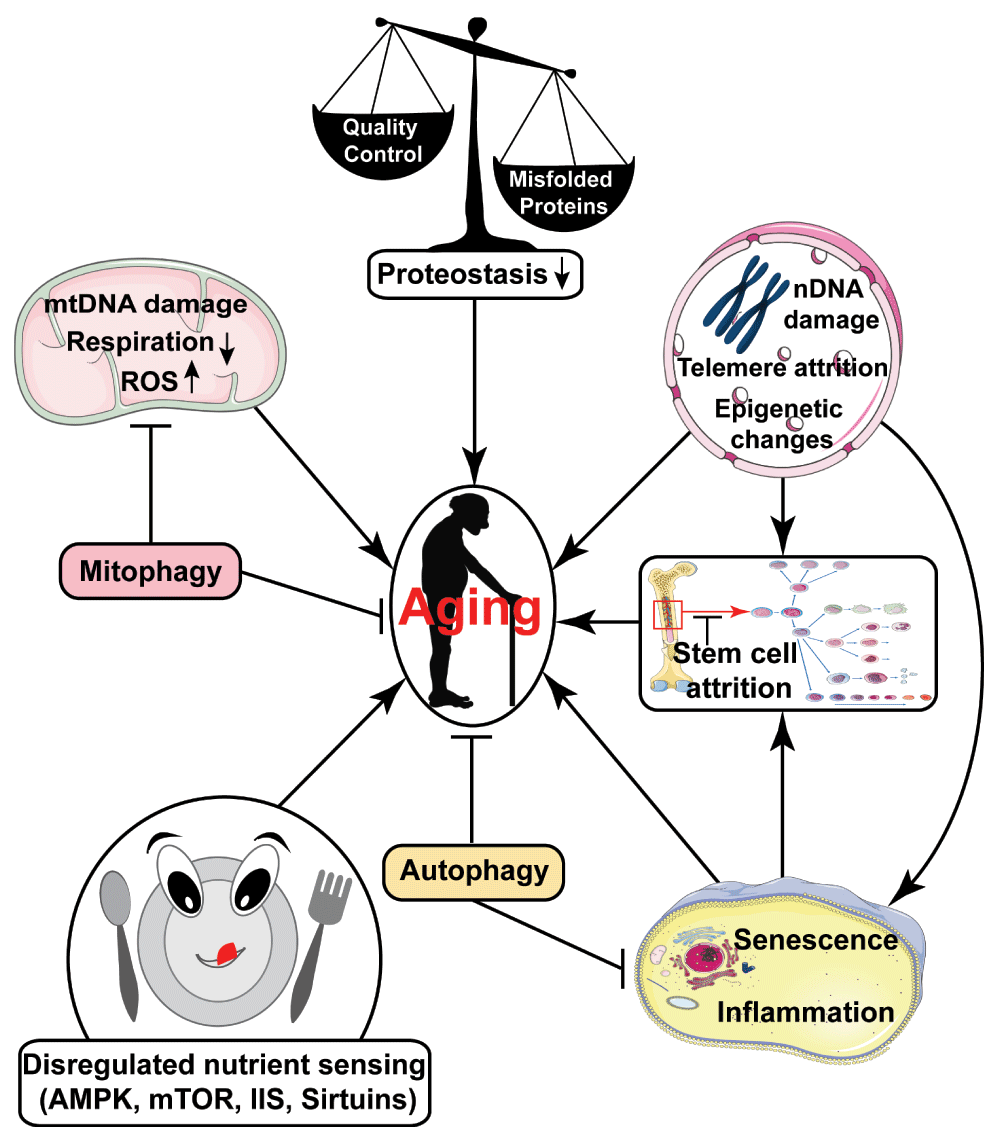
Conclusions
So, where do does this information take us? Our view is this:
- There is no substitute for exercise and a healthy diet, so keep on doing that.
- Get periodic V-Cell treatments [periodic infusions of autologous V-cells plus growth factors and cytokines]. Recommended periodicity may vary, depending on one’s age and other factors. More details on V-cell treatments are set out on the V-Cell page.
- Consider an appropriate regime of anti-aging life extending patch, IV and supplement treatments suitable to your personal needs.
Who Can Benefit?
Many people at different stages in life can benefit.
- Seniors can help reverse diseases of ageing and live a healthier life, often with less pain and reduced loss of faculty.
- Senior executives can extend their useful working lives with better health and mental function.
- Young executives, starting earlier while their cells’ telomere lengths are long, can expect significantly to extend their health, mental efficiency and possibly youthfulness.
To learn more or to determine which treatment is best suited to your needs, please contact us.
Further Reading
For an abstract of clinical trials on telomere lengthening, please contact us.
